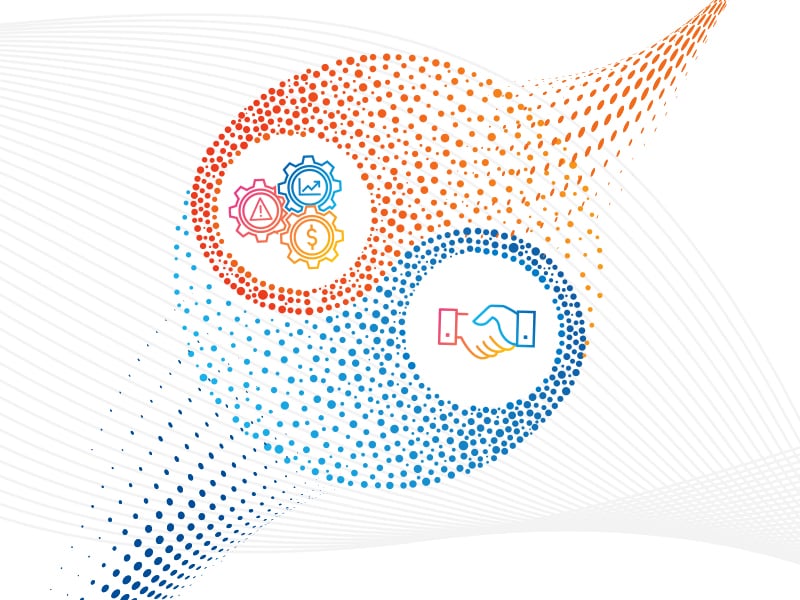Home > Blogs > Automation to AI – The inevitable journey of enterprises
Automation to AI – The inevitable journey of enterprises

Artificial Intelligence (AI) has been advancing much quicker than before, becoming the most talked-about technology of our time. As enterprises get set to embrace this new technology, they also tackle various doubts that arise time to time. Doubts about AI’s implementation, success, ROI and their eventual journey from intelligent automation to artificial intelligence. To get a clear picture of AI’s state of market and state of implementation, EdgeVerve conducted an in-depth research in collaboration with AIIA and surveyed over 100 business executives and industry experts from around the globe. Of those interviewed, many were responsible for overseeing operations across more than one sector (53%), with automotive, BFSI (banking, financial services and insurance) and IT forming the most strongly represented industries.
There are many who note the growing potential for AI within their industry, but still relatively few (less than one in five) have a strategy in place to manage the transition from automation to AI. The majority of enterprise professionals are at the very beginning of their artificial intelligence journey – 24% are in the planning phase, and 40% are yet to begin but have plans to. Despite recognizing the potential to move from intelligent automation to AI, less than one fifth of enterprise organizations have a strategy in place to manage this transition.
Why this trend?
Looking at the current state of AI investments, it is quite clear that CEOs or equivalent leaders are the ones driving AI investments within an organization. The survey results reflect a top down trend, with more than a third of respondents (39%) indicating that C-suite leaders were driving AI implementation within their organizations. However, the somewhat surprising result is that a quarter of respondents indicated the CEO as the key driver of this change. SVP & Global Head of Product Management & Strategy Infosys, Sudhir Jha says, “I have seen a lot more projects driven by the CIO, CTO or IT department within an organization.”
To fully integrate employees into successful AI deployment, organizations will need to leverage AI to augment existing human skills and make employees better at their work as well as focus on employee training to help them develop adaptable skills for the future. A seasoned professional and thought leader in Robotic Process Automation and AI, Malay Saurabh says “When it comes to implementing automation and AI, change has to be driven from the top down. In my experience, when initiatives have been driven from the bottom up, they usually get stuck somewhere.”
Key to AI implementation success
An adaptable and scalable tool, artificial intelligence is being implemented across functions to augment workforces responsible for operations and customer service, finance and accounting, and sales and marketing – to name a few.
For AI implementation to be successful, AI investment needs buy in from stakeholders at the top because of the level of changes to both people and technology throughout the organization. Despite passionate concerns and potential implications of AI, the technology holds enormous potential for human empowerment and gives us the tools necessary to spot patterns within new and existing data and uncover important insights that would possibly make our lives better.
From automation to AI – The eventual path
Despite discussions about the potential to move from intelligent automation to AI, the research findings indicate that less than a quarter (18%) of organizations has a strategy in place to manage this transition.
However, there are a few positives too. Some organizations are already experiencing the benefits of AI as it becomes mainstream in business. There is a fear amongst those who are not already experimenting with AI, that they will be left behind (given a long enough time horizon, this will likely be the case). While the majority are yet to implement AI, 40% of organizations are seeking more information with a plan to invest longer term. In order to remain competitive, businesses investing in AI should also invest in their employees. As AI increases in scale and drives further change, businesses that embrace training and re-skilling current employees will realize tangible benefits.
In conclusion, the move from automation to AI – whether accidental or strategic – is a definite pathway among companies. Simple automation gives you a clear ROI to get the justification for the overall project, and then you can use some of those benefits to invest in intelligent automation for bigger benefits. It is quite evident that one has to get some predictive and cognitive capability added on to their automation in order to impact the top line. Eventually, all enterprises would move to AI, it is only a matter of time.


Surbhi Sharma
More blogs from Surbhi >